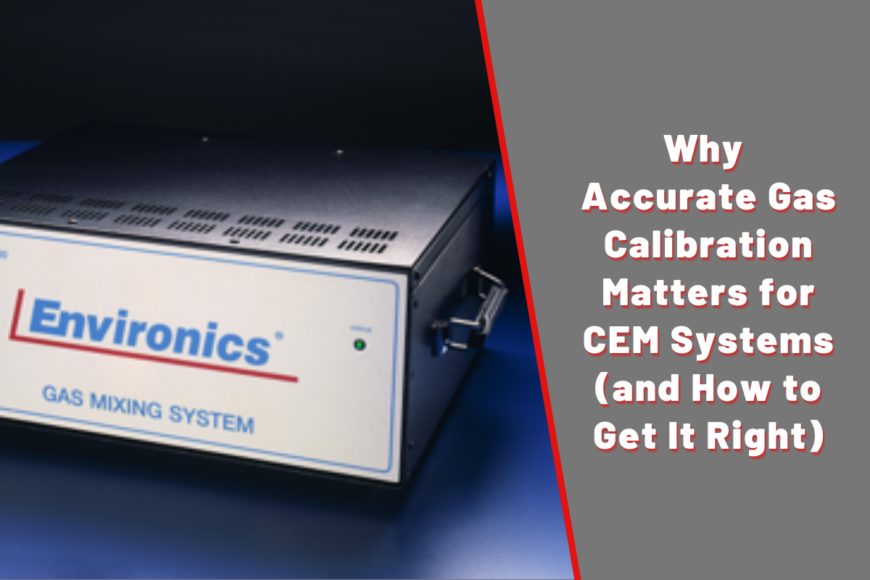
CEM systems monitor gases at the source of industrial emissions, producing data that must be both precise and defensible. The trust placed in that data, by regulators, engineers, and environmental managers alike, depends on one fundamental condition: accurate gas calibration.
When calibration is neglected or imprecise in a CEM system, the integrity of every reading begins to erode. What appears to be valid data may in fact be misleading, compromising compliance reporting and distorting process control. Calibration is not an afterthought. It is the mechanism that transforms a CEM system from technical instrumentation into a source of environmental accountability and operational insight.
Why Accuracy in Calibration Is Non-Negotiable
Precision in emissions monitoring is a fundamental expectation in regulated industries. The accurate calibration of CEM systems protects data integrity so organizations can comply with emissions limits, maintain transparency, and operate pollution controls effectively. Reliable calibration enables confident decisions based on real emissions conditions.
Accurate Calibration Anchors Reliable Emissions Data
CEM systems are precision instruments. They quantify gases that are often regulated in parts per million. This level of sensitivity is only meaningful when the system is correctly calibrated to known standards. Gas analyzers are susceptible to drift caused by temperature, pressure, aging components, or contamination. Calibration corrects that drift and ensures that what is measured matches the reality of emissions at the stack.
Compliance Is Built on Calibrated Measurements
Environmental regulations do not leave room for ambiguity. Protocols like the EPA’s 40 CFR Parts 60 and 75 specify performance tests for CEM systems that hinge entirely on accurate calibration. If drift is not corrected or if span checks fall outside of limits in a CEM system, the data collected becomes invalid for compliance purposes. That invalidation can carry serious consequences, including financial penalties, permit violations, or mandated reporting corrections.
Inaccurate Readings Distort Operational Decisions
Many facilities use real-time data from CEM systems to adjust combustion controls, chemical dosing, and pollution abatement systems. Should calibration within a CEM system be inaccurate, the data driving those controls becomes unreliable. A misreading on NOx concentrations could result in excessive reagent use, driving up costs. Conversely, underreporting may lead to unaddressed exceedances, missed violations, or even safety risks. Proper calibration keeps CEM systems and their associated control systems operating on a trustworthy foundation.
Calibration Connects Instruments to Standards
Each successful calibration links the CEM system’s measurements to an authoritative reference. Using certified gas mixtures with documented traceability to institutions such as NIST ensures that every data point is rooted in an internationally recognized standard.
Getting Gas Calibration Right: A Practical Guide
Effective calibration goes beyond simply following a schedule. It requires precise material choices, consistent delivery systems, and procedures that align with the complete architecture of the monitoring system. Here’s how to ensure your calibration process is robust:
Select Certified, Traceable Gases
Calibration gases must be certified and traceable to recognized standards such as those provided by NIST. The gas concentration should match or bracket the expected emission ranges. Each gas must also include documented uncertainty, expiration dates, and traceability certificates. Poor-quality or expired gas invalidates calibration from the outset.
Deliver with Precision
Gas must be delivered through compatible, clean lines using pressure-stable, corrosion-resistant regulators. Flow rates must be consistent and verifiable. Fluctuations in pressure or contamination in lines can skew calibration and introduce long-term measurement errors.
Calibrate the Full Measurement Path
For comprehensive accuracy, calibration gas should be introduced at the probe inlet rather than directly into the analyzer. This method ensures that every component, including the probe, filters, sample lines, and measurement cell, is functioning correctly under real sampling conditions.
Automate Daily Checks
Automated calibration sequences allow CEM systems to perform daily zero and span checks without operator intervention. These sequences reduce human error, provide consistent baselines, and ensure timely corrective actions when drift exceeds set limits.
Maintain Rigorous Records
Complete documentation is critical. Calibration logs should include gas cylinder IDs, analyzer responses, ambient conditions, and any adjustments made. A historical record supports compliance audits and reinforces internal quality control practices.
Environics’ Commitment to Calibration Excellence
Environics’ CEM calibration systems are engineered for environments where accuracy cannot be compromised. With the ability to dilute high-concentration Protocol-1 or certified gases down to trace levels, our systems enable dependable calibration at a fraction of the cost and complexity of conventional methods.
Key benefits of Environics’ calibration systems include:
- Repeatability within ±0.05% of full scale
- Traceability to NIST standards
- Reduction in gas usage and rental costs by up to 60 percent
- Automated calibration with robust audit trails
- Compatibility with 24V power for field deployment.
Designed to meet and exceed EPA Method 205 requirements, Environics’ systems can support the most demanding CEM applications. Whether for mobile labs, permanent stacks, or multi-analyzer networks, our technology delivers repeatable results you can trust.
Accuracy That Delivers Confidence
Reliable calibration practices are what separate compliant operations from those at risk of penalties or performance failures. Without verified accuracy, even the most sophisticated CEM system cannot be depended upon to inform decisions or validate reports.
Explore Environics’ calibration systems to achieve accurate, compliant emissions data backed by proven reliability.

